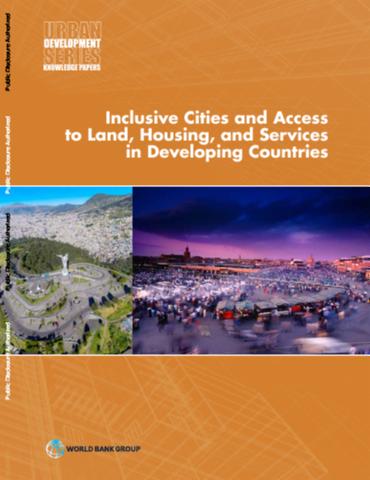Inclusive cities and access to land, housing, and services in Developing Countries
 Paralleling the increasing disparities in income and wealth worldwide since the 1980s, cities in developing countries have witnessed the emergence of a growing divergence of lifestyles, particularly within the middle classes, reinforced by the widening gap between the quality of public and private educational and health care institutions, spatial segregation, gated communities, and exclusive semiprivate amenities. This erosion of social cohesion and citizenship in urban society has sharpened the growing perception and reality of exclusion. This book is arranged as follows: chapter one discusses on the growing importance of inclusion in urban areas; chapter two describes trends affecting social inclusion in urban areas; chapter three focuses on infrastructure and public services: a powerful tool to promote social inclusion; chapter four explains restoring the social function of public space; chapter five deals with access to land: a critical factor at the core of inclusion and exclusion; chapter six describes the erosion of inclusive options for affordable housing; chapter seven talks about generating revenues to finance urban improvements: land-based financing; chapter eight focuses on the right to the city; chapter nine describes Nongovernmental Organizations (NGO) and Community-Based Organizations (CBO) as strategic partners in driving the implementation of inclusionary programs; and chapter ten has concluding remarks.
Paralleling the increasing disparities in income and wealth worldwide since the 1980s, cities in developing countries have witnessed the emergence of a growing divergence of lifestyles, particularly within the middle classes, reinforced by the widening gap between the quality of public and private educational and health care institutions, spatial segregation, gated communities, and exclusive semiprivate amenities. This erosion of social cohesion and citizenship in urban society has sharpened the growing perception and reality of exclusion. This book is arranged as follows: chapter one discusses on the growing importance of inclusion in urban areas; chapter two describes trends affecting social inclusion in urban areas; chapter three focuses on infrastructure and public services: a powerful tool to promote social inclusion; chapter four explains restoring the social function of public space; chapter five deals with access to land: a critical factor at the core of inclusion and exclusion; chapter six describes the erosion of inclusive options for affordable housing; chapter seven talks about generating revenues to finance urban improvements: land-based financing; chapter eight focuses on the right to the city; chapter nine describes Nongovernmental Organizations (NGO) and Community-Based Organizations (CBO) as strategic partners in driving the implementation of inclusionary programs; and chapter ten has concluding remarks.
